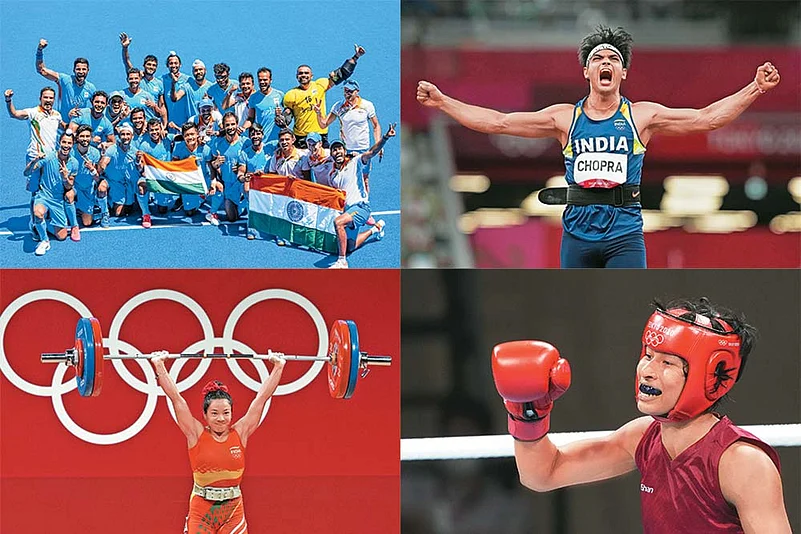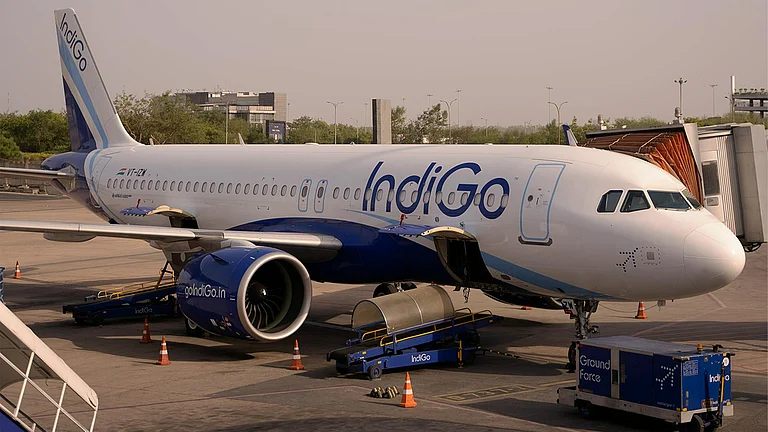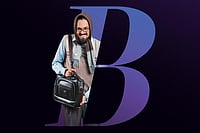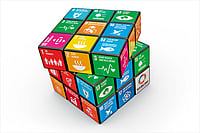Parth Jindal’s phone has not stopped ringing ever since Neeraj Chopra won India’s sole gold medal in javelin at the recently concluded Tokyo Olympic Games. It comes as no surprise as Jindal is the director of JSW Sports, the organisation that manages the athlete.
“I haven’t received as many calls in five years as I have since he won the medal,” Jindal tells Outlook Business.
In a country where an Olympic gold is a rare sporting feat, Chopra’s victory catapulted him into stardom overnight, with brands and authorities scrambling to outdo one another by announcing rewards and more.
“For corporates and India Inc, he is a brand prospect like no other. He is a relatable character who comes from a small town in Haryana, eats choorma, and plays a sport relatable to the masses,” a cheerful Jindal adds.
The upshot—ongoing talks with over 30 brands for endorsement deals, with their value likely to jump over 10 times as compared to the pre-Olympic period.
Like moths to a flame, brands are drawn to the aureole of sporting glory. And when success has been achieved at a global platform unparalleled for its competitiveness, attempts to partake in it become unrelenting.
Apart from Chopra, India’s six other Tokyo 2020 medallists, too, are basking in the spotlight, with brands announcing a lifetime supply of free pizzas, air travel and other goodies to honour their achievement.

In the afterglow of the stellar Olympic performances, it seems that corporations are finally waking up to sports and stars beyond cricket. At first glance, things do seem to be improving. The Indian Olympic Association (IOA) has seen a surge of corporate sponsors—13 got on board, with the total value of sponsorships going up by 40 per cent as compared to the 2016 Rio Olympics. The IOA raked in a total of Rs 25 crores from brands such as Mobile Premier League (MPL), Edelweiss, INOX Group, Amul and JSW Group. (See: Indian corporates warm up to Olympics)
The pre-tournament sponsorship was also surprisingly good, considering the uncertainty surrounding the Tokyo Olympics, says Neerav Tomar, managing director of sports management firm IOS Sports & Entertainment. “The postponement was a big drawback. Amid the second Covid-19 wave in the country, we had to wait for the right time. Most of the deals were made in the first week of June, with the Adani Group coming on board as late as the opening day of the event,” he says.
However, the struggle to get sponsors for the Olympics and Olympic sports in India predates the pandemic. It was only in 2016 that the IOA signed up an exclusive agency to generate sponsorship revenue—the first time it hired a professional sports marketing firm to shore up corporate interest.
IOS, which was set up in 2005, had to deal with negligible interest and a very tiny share for Olympic sports in the marketing industry. However, the medals won at the 2008 Beijing Olympics—especially Abhinav Bindra’s shooting gold, the first ever by an individual Indian sportsperson—were a breakthrough. Suddenly, corporates were piqued, Tomar says, as they were looking for influencers for their brands. Stars such as Saina Nehwal and Mary Kom were a shot in the arm for athletes. (See: India’s medals tally over the years)

A Temporary Spotlight?
Anyone who followed Indian sportspersons’ progress in Tokyo 2020 would have noticed how brands jumped in to make the most of the euphoric moments. However, the temporary spotlight or “moment marketing” by brands has irked some people in the industry.
For instance, Yashwanth Biyyala, director of talent and partnerships at sports management agency Baseline Ventures, has been uncommonly busy of late. Baseline, which manages badminton star P.V. Sindhu, has sent legal notices to over 20 companies for leveraging the star’s medal in Tokyo and using her images without consent, especially on digital platforms. The agency is seeking Rs 50 million in damages for violation of IP and privacy rights from firms such as Pan Bahar, Eureka Forbes, ICICI Bank and others.
“Some of these brands have disregarded potential brand association discussions in the past but are now suddenly trying to get a piece of Sindhu’s glory through social media posts in the garb of congratulating her,” Biyyala points out. JSW’s Jindal, on the other hand, says that while such posts are in “bad taste”, the company was not considering similar legal actions at the moment.
But, for all the interest in Olympic sports and athletes, analysts and corporations remain sceptical about a long-term shift in the sports marketing industry. “We Indians have short memories and though the Olympics was received really well this time and generated many interactions, we’re not sure if this indeed will be a gamechanger, from a sports marketing perspective,” independent sports consultant Anubhav Roda says.
Cricket, of course, remains the chief attraction for brands. “We had already started to see brands being open about looking beyond cricket with more investment being on leagues rather than athletes and we will see some temporary traction. But with IPL, T20 World Cup and then again next year’s IPL, I see the effect fading,” adds Roda.
With the Olympics coming once in four years and most championships related to Olympic sports either being annual in nature or not televised in India, brand visibility of the stars related to them is typically much lower than that of cricketers.
“It’s for Olympic sports and stars to bridge the gap with cricket, because cricket is always on. You keep seeing the stars on your screens. It’s a great marketing tool and more individualistic in nature,” says Jindal.
In a nation that is perennially sozzled on cricket, a gap in sponsorship is understandable, analysts say. The sheer width of it, however, is staggering. In a report, GroupM ESP, the entertainment, e-sports and sports division of GroupM India, estimated the size of the Indian sports industry to be at Rs 58.94 billion in 2020. Cricket claims a whopping 87 per cent share of the total sports sponsorship pie.
Funnily enough, for this year’s Tokyo Olympics, the biggest contribution came in the form of a ‘donation’ by the Indian cricket board, BCCI, which gave Rs 10 crore, following a request by the cash-strapped IOA. To put things into perspective, that’s just slightly more than what BCCI pays Virat Kohli under his annual contract. At the government level, too, India’s spending on Olympic sports is minuscule. In fact, the government cut the sports budget by Rs 2.31 billion in the Olympic year.
For individual stars, winning medals has certainly helped them increase their brand value, but compared to top cricketers, a massive difference persists. For instance, the brand value of Sindhu—the only Indian woman to win two Olympic medals—is 1/20th that of Kohli’s. According to consultancy firm Duff & Phelps, Sindhu had about 10 endorsements at the end of 2020 and her brand value was about $12 million, as against Kohli’s $237 million.
Apart from the value, there is a huge chasm between the number of endorsement deals going towards cricket and non-cricket stars. As per the GroupM ESP report, of the 377 endorsement deals that happened last year, 275 involved cricketers.
All About The Stars
The rise of stars in individual sports has not translated to greater corporate interest in their respective sporting disciplines and their corresponding leagues at a broader level.
“We are not a sporting nation. We are more of a hero-worshipping nation. So, initially, awareness of the sport comes through star athletes who bring glory to their country,” Prasad Mangipudi, managing director, Sportzlive, says.
Sportzlive organises the Premier Badminton League (PBL) which was inaugurated in 2016 amid much fanfare, but has, since then, struggled to draw the desired sponsorship support. Last year, Star Sports, the broadcast and inventory rights holders for the PBL, took over the title sponsorship rights since it could not find a replacement for Vodafone. The mobile service provider had declined to extend its title sponsorship contract on completion of its four-year deal.
“These are still early days for Olympic sport leagues like PBL. Last February, we completed five seasons and hoped for a big jump in sponsors subsequently. But due to the Covid-19 pandemic, we have been set back by a few years. This will reduce the sponsor pool,” Mangipudi adds.
Then there is hockey, India’s hallowed national game and a source of immense national pride, that gave two great surprises to the country in Tokyo. Yet, investment in the sport through sponsorships is discouraging and indicative of serial neglect.
In an unprecedented move, a state government decided to sponsor the national hockey team amid a lack of funding. In 2018, the Odisha government announced a five-year deal with Hockey India to replace Sahara as the sponsor of all national teams—junior and senior, men and women—in a deal pegged at Rs 1.5 billion. Odisha came on board after Hockey India’s deal with Sahara was terminated ‘mutually’. Although their contract amount for the 2017-2021 period was not made public, it is believed that Sahara paid close to Rs 40 crore for the five-year period from 2012 to 2017. To put things into perspective, Vivo paid more than Rs 4 billion to sponsor a single edition of the IPL. (See: IPL still dwarfs other tournaments)
In other words, in the sports marketing and sponsorship industry, nothing less than a paradigm shift is required for a more favourable shift towards Olympic disciplines and stars.
Baseline’s Biyyala says that there is a lot that sporting federations, private leagues and tournaments need to do to improve visibility of tournaments. “While athletes have been doing their bit by building social media followers, they do have a limitation with respect to visibility on TV. A lot of tournaments are not even broadcast in India.”
With visibility being low, corporations are trying to look at other angles. “We are talking to brands and telling them about the difficulty of winning an Olympic medal. Supporting an Olympic athlete is also more patriotic in nature,” Jindal points out. He adds that brands are also trying to diversify as cricket is a thoroughly crowded space.
Just ‘Goodwill’ Marketing Or More?
For most corporate firms, despite attempts at diversification, sponsorship in non-cricket sports comes in the form of donations, monetary gestures or ‘philanthropy’. Big names such as the Adani Group and Reliance Industries have adopted this view with the Adani Sportsline and Reliance Foundation Youth Sports supporting Olympic sports and athletes.
Even for Tokyo 2020, it was MPL Sports Foundation, the community arm of e-sports platform Mobile Premier League, which came forward as the principal sponsor in a deal worth Rs 8 crore. The deal also covers the Asian and Commonwealth Games next year. “Sports philanthropy is central to our vision,” says Dibyojyoti Mainak, senior vice president (policy and legal), MPL. “As a start-up that fortunately has been doing well in the last couple of years, we thought that our duty extended beyond just the bare minimum,” he adds.
Other new-age tech start-ups such as CRED, WazirX and Dream11 have, however, opted for the safer option of focusing on cricket. Sponsors want to lap up the “human spirit of feeling good” that the Olympic Games bring, Tomar says. However, the flow of money still depends on eyeballs and no sport can catch up with cricket, even in the next few decades, he cautions.
Brands have also been criticised for coming on board after athletes get medals but being unwilling to support them in their journey to the Olympics—a years-long, blood-and-guts preparatory phase. This has invited strong reactions from players who have represented and made India proud in previous Olympic Games. In one such outburst on Twitter, tennis star Mahesh Bhupathi said that the country had to “wake up” and that “nothing is better in my sport from the time I was playing”. In another tweet, he added: “Absolutely absurd that a country of our size and talent have to pray that more firms like JSW Sports and Olympic Gold Quest come around and get things done privately. If there is no system you can’t expect miracles. At best expect a handful in a good Olympic year at best (sic).”
The Road To Paris
With the next Olympics just three years away, some corporations have been trying innovative means to bridge the gap between cricket and Olympic sports. MPL, for instance, sees a possible convergence between online gaming and the offline sports industry. “In the physical world, cricket does rule the roost, but when it comes to the world of online sports, there’s absolutely no such dominance. Shooting, for example, is way more popular than cricket. We see very good numbers in chess and archery. The playing field is much more level,” Mainak says.
Significantly, the International Olympic Committee has recognised this and started the Olympic Virtual Series—the first-ever, licensed virtual competition covering five sports. MPL, on its part, has joined hands with the National Rifle Association of India to develop a mobile version of a non-violent shooting game with the International Shooting Sport Federation-style trap and skeet formats.
“Such games will allow fans to get a real look and feel of other sports, understand the rules and get behind the icons,” says Mainak.
Others see a growing role for corporations to pitch in. JSW, for instance, is optimistic about a 20-medal haul at the 2024 Olympics and a 200-member Indian delegation. For that to happen, cohesive work between the public and the private sector is needed, Jindal stresses. “We cannot replace the government, can just work with them,” he says.
Baseline is taking a slightly different approach. It is planning to launch the Prime Volleyball League along the lines of iconic American sports bodies like the NBA, where the league is not necessarily in partnership with the national federation. Biyyala is hopeful that this will give the private body freedom to develop and grow the sport, with players and fans as its most important stakeholders, while keeping politics out.
For these measures to catch on and come to fruition, much work, ingenuity, luck and steady support are essential and time shall be their unsparing judge. For now, it’s time for the new Olympic stars to enjoy the sweet fruits of their success. For, as long as the frisson of their achievement lasts, brands will court them unabashedly.






























